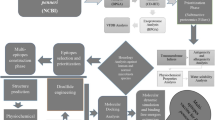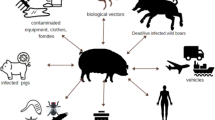Abstract
The current experiment was conducted to construct recombinant Bacillus subtilis WB600 expressing Eimeria tenella 3-1E protein to investigate the oral immunization protective effects against E. tenella. The merozoite surface antigen 3-1E gene of E. tenella was introduced into the pBS-H1 expression vector with a novel signal peptide sequence. After the electro-transformation, the expression of objective protein in B. subtilis WB600 was detected by Western blot. The results showed that the recombinant B. subtilis strain with the ability of high-level secretion of 3-1E was constructed successfully. Seven-day-old broiler chickens were orally vaccinated with B. subtilis WB600 harboring 3-1E (B.S-pBS-H1-3-1E) or B. subtilis WB600 with empty plasmid (B.S-pBS-H1) 10 days prior to challenge with sporulated E. tenella oocysts. The results showed the recombinant B. subtilis strain with the ability of high-level secretion of 3-1E was constructed successfully. Vaccination with B.S-pBS-H1-3-1E strain significantly increased the anti-coccidial index and reduced cecal lesion scores compared with the positive control group (chickens were challenged with sporulated E. tenella oocysts without oral administration of B.S-pBS-H1-3-1E strain) and B.S-pBS-H1 group. Ceca mucosal sIgA, secretion, and IL-2, IL-12, IFN-γ, and IL-10 level after challenge were greater in the B.S-pBS-H1-3-1E group than in the positive control group. Taken together, these results indicated that B. subtilis WB600 harboring 3-1E protein induces protective immunity against E. tenella.



Similar content being viewed by others
References
Abi-Ghanem D, Waghela SD, Caldwell DJ, Danforth HD, Berghman LR (2008) Phage display selection and characterization of single-chain recombinant antibodies against Eimeria tenella sporozoites. Vet Immunol Immunopathol 121:58–67
Chapman HD, Shirley MW (2003) The Houghton strain of Eimeria tenella: a review of the type strain selected for genome sequencing. Avian Pathol 32:115–127
Choi KD, Lillehoj HS, Zalenga DS (1999) Changes in local IFN-gamma and TGF-beta4 mRNA expression and intraepithelial lymphocytes following Eimeria acervulina infection. Vet Immunol Immunopathol 71(3–4):263–275
Cornelissen JB, Swinkels WJ, Boersma WA, Rebel JM (2009) Host response to simultaneous infections with Eimeria acervulina, maxima and tenella: a cumulation of single responses. Vet Parasitol 162(1–2):58–66
Dalloul RA, Lillehoj HS (2006) Poultry coccidiosis: recent advancements in control measures and vaccine development. Expert Rev Vaccines 5(1):143–163
Dalloul RA, Lillehoj HS, Shellem TA, Doerr JA (2003) Enhanced mucosal immunity against Eimeria acervulina in broilers fed a Lactobacillus-based probiotic. Poultry Sci 82(1):62–66
Ferreira LC, Ferreira RC, Schumann W (2005) Bacillus subtilis as a tool for vaccine development: from antigen factories to delivery vectors. Ann Acad Bras Cienc 77:113–124
Fu LL, Li WF, Du HH, Dai W, Xu ZR (2008) Oral vaccination with envelope protein VP28 against white spot syndrome virus in Procambarus clarkii using Bacillus subtilis as delivery vehicles. Lett Appl Microbial 46(5):581–586
Fu LL, Wang Y, Wu ZC, Li WF (2011) In vivo assessment for oral delivery of Bacillus subtilis harboring a viral protein (VP28) against white spot syndrome virus in Litopenaeus vannamei. Aquaculture 322–323:33–38
Heydari A, Moosazadeh Moghaddam M, Aghamollaei H, Yakhchali M, Bambaee B, Latifi A (2013) Cloning and expression of the Bacillus pumilus F3 lipase gene into Bacillus subtilis and determining of comparative expression level between native and recombinant enzyme. New cell Mol Biotech J 3(9):67–73
Inagaki-Ohara K, Dewi FN, Hisaeda H, Smith A, Jimi F, Miyahira M, Abdel-Aleem AS, Horii Y, Nawa Y (2006) Intestinal intraepithelial lymphocytes sustain the epithelial barrier function against Eimeria vermiformis infection. Infect Immun 74(9):5292–5301
Jang SI, Lillehoj HS, Lee SH, Lee KW, Park MS, Bauchan GR, Lillehoj EP, Bertrand F, Dupuis L, Deville S (2010) Immunoenhancing effects of Montanide™ ISA oil-based adjuvants on recombinant coccidia antigen vaccination against Eimeria acervulina infection. Vet Parasitol 172(3–4):221–228
Jang SI, Lillehoj HS, Lee SH, Lee KW, Lillehoj EP, Bertrand F, Dupuis L, Deville S (2011) Mucosal immunity against Eimeria acervulina infection in broiler chickens following oral immunization with profilin in Montanide™ adjuvants. Exp Parasitol 129(1):36–41
Johnson J, Reid WM (1970) Anticoccidial drugs: lesion scoring techniques in battery and floor-pen experiments with chickens. Exp Parasitol 28(1):30–36
Lee SH, Lillehoj HS, Dalloul RA, Park DW, Hong YH, Lin JJ (2007) Influence of Pediococcus-based probiotic on coccidiosis in broiler chickens. Poultry Sci 86(1):63–66
Lee SH, Lillehoj HS, Park DW, Jang SI, Morales A, Garcia D, Lucio E, Larios R, Victoria G, Marrufo D, Lillehoj EP (2009) Protective effect of hyperimmune egg yolk IgY antibodies against Eimeria tenella and Eimeria maxima infections. Vet Parasitol 163:123–126
Lee S, Belitsky BR, Brinker JP, Kerstein KO, Brown DW, Clements JD, Keusch GT, Tzipori S, Sonenshein AL, Herrmann JE (2010a) Development of a Bacillus subtilis-based rotavirus vaccine. Clin Vaccine Immunol 17:1647–1655
Lee SH, Lillehoj HS, Jang SI, Lee KW, Yancey RJ, Dominowski P (2010b) The effects of a novel adjuvant complex/Eimeria profilin vaccine on the intestinal host immune response against live E. acervulina challenge infection. Vaccine 28(39):6498–6504
Lillehoj HS, Lillehoj EP (2000) Avian coccidiosis. A review of acquired intestinal immunity and vaccination strategies. Avian Dis 44(2):408–425
Lillehoj HS, Ruff MD (1987) Comparison of disease susceptibility and subclass-specific antibody response in SC and FP chickens experimentally inoculated with Eimeria tenella, E. acervulina, or E. maxima. Avian Dis 31(1):112–119
Lillehoj HS, Min W, Dalloul RA (2004) Recent progress on the cytokine regulation of intestinal immune responses to Eimeria. Poultry Sci 83:611–623
Luiz WB, Cavalcante RC, Paccez JD, Souza RD, Sbrogio-Almeida ME, Ferreira RC, Ferreira LC (2008) Boosting systemic and secreted antibody responses in mice orally immunized with recombinant Bacillus subtilis strains following parenteral priming with a DNA vaccine encoding the enterotoxigenic Escherichia coli (ETEC) CFA/I fimbriae B subunit. Vaccine 26(32):3998–4005
Ma D, Ma C, Pan L, Li G, Yang J, Hong J, Cai H, Ren X (2011) Vaccination of chickens with DNA vaccine encoding Eimeria acervulina 3-1E and chicken IL-15 offers protection against homologous challenge. Exp Parasitol 127(1):208–214
Ma D, Gao M, Dalloul RA, Ge J, Ma C, Li J (2013) Protective effects of oral immunization with live Lactococcus lactis expressing Eimeria tenella 3-1E protein. Parasitol Res 112(12):4161–4167
McDougald LR, Reid WM (1991) Coccidiosis. In: Calnek BW, Barnes HJ, Beard CW, Reid WM, Yoder HW (eds) Diseases of poultry. Iowa State University Press, Ames, Iowa, pp 780–797
Min W, Lillehoj HS, Burnside J, Weining KC, Staeheli P, Zhu JJ (2001) Adjuvant effects of IL-1beta, IL-2, IL-8, IL-15, IFN-alpha, IFN-gamma TGF-beta4 and lymphotactin on DNA vaccination against Eimeria acervulina. Vaccine 20(1–2):267–274
Mosmann TR, Sad S (1996) The expanding universe of T-cell subsets: Th1, Th2 and more. Immunol Today 17(3):138–146
Nicholson WL, Setlow P (1990) Sporulation, germination and outgrowth. In: Harwood CR, Cutting SM (eds) Molecular biological methods for Bacillus. Wiley Press, Chichester, UK, pp 391–450
Paccez JD, Luiz WB, Sbrogio-Almeida ME, Ferreira RC, Schumann W, Ferreira LC (2006) Stable episomal expression system under control of a stress inducible promoter enhances the immunogenicity of Bacillus subtilis as a vector for antigen delivery. Vaccine 24(15):2935–2943
Paccez JD, Nguyenb HD, Luiza WB, Ferreiraa RCC, Sbrogio-Almeidac ME, Schumanb W, Ferreiraa LCS (2007) Evaluation of different promoter sequences and antigen sorting signals on the immunogenicity of Bacillus subtilis vaccine vehicles. Vaccine 25(24):4671–4680
Sathish K, Sriraman R, Subramanian BM, Rao NH, Kasa B, Donikeni J, Narasu ML, Srinivasan VA (2012) Plant expressed coccidial antigens as potential vaccine candidates in protecting chicken against coccidiosis. Vaccine 30:4460–4464
Song KD, Lillehoj HS, Choi KD, Yun CH, Parcells MS, Huynh JT, Han JY (2000) A DNA vaccine encoding a conserved Eimeria protein induces protective immunity against live Eimeria acervulina challenge. Vaccine 19(2–3):243–252
Subramanian BM, Sriraman R, Rao NH, Raghul J, Thiagarajan D, Srinivasan VA (2008) Cloning, expression and evaluation of the efficacy of a recombinant Eimeria tenella sporozoite antigen in birds. Vaccine 26:3489–3496
Tseng DY, Ho PL, Huang SY, Cheng SC, Shiu YL, Chiu CS, Liu CH (2009) Enhancement of immunity and disease resistance in the white shrimp, Litopenaeus vannamei, by the probiotic, Bacillus subtilis E20. Fish Shellfish Immun 26(2):339–344
Wang J, Thorson L, Stokes RW, Santosuosso M, Huygen K, Zganiacz A, Hitt M, Xing Z (2004) Single mucosal, but not parenteral, immunization with recombinant adenoviral-based vaccine provides potent protection from pulmonary tuberculosis. J Immunol 173(10):6357–6365
Williams RB (2006) Relative virulences of a drug-resistant and a drug-sensitive strain of Eimeria acervulina, a coccidium of chickens. Vet Parasitol 135(1):15–23
Xue GP, Johnson JS, Dalrymple BP (1999) High osmolarity improves the electro-transformation efficiency of the gram-positive bacteria Bacillus subtilis and Bacilluslicheniformis. J Microbiol Method 34:183–191
Yun CH, Lillehoj HS, Choi KD (2000) Eimeria tenella infection induces local gamma interferon production and intestinal lymphocyte subpopulation changes. Infect Immun 68(3):1282–1288
Zhang DF, Xu H, Sun BB, Li JQ, Zhou QJ, Zhang HL, Du AF (2012a) Adjuvant effect of ginsenoside-based nanoparticles (ginsomes) on the recombinant vaccine against Eimeria tenella in chickens. Parasitol Res 110:2445–2453
Zhang L, Liu RQ, Ma LP, Wang YW, Pan BL, Cai JP, Wang M (2012b) Eimeria tenella: expression profiling of toll-like receptors and associated cytokines in the cecum of infected day-old and three-week old SPF chickens. Exp Parasitol 130(4):442–448
Zhao YL, Wang CM, Lu YM, Amer S, Xu P, Wang JY, Lu JX, Bao YZ, Deng BL, He HX, Qin JH (2011) Prokaryotic expression and identification of 3-1E gene of merozoite surface antigen of Eimeria acervulina. Parasitol Res 109:1361–1365
Acknowledgments
The present research was funded by Science and Technology Program of Zhejiang Province (No.2011C16039) and Science and Technology Program of Hangzhou (No.20120232B26). The authors also thank Zhusuo Wang (Director of Chia Tai Broiler Development Center, Zhejiang University, China) for his kind assistance with the feeding trial.
Conflict of interest
The authors declare that they have no competing interest.
Author information
Authors and Affiliations
Corresponding authors
Additional information
Zhiwei Lin and Yanyun Shi contributed equally to this work.
Electronic supplementary material
Below is the link to the electronic supplementary material.
ESM 1
Analysis of recombinant coccidial antigen 3-1E by MALDI-TOF (PDF 475 kb)
Rights and permissions
About this article
Cite this article
Lin, Z., Shi, Y., Deng, B. et al. Protective immunity against Eimeria tenella infection in chickens following oral immunization with Bacillus subtilis expressing Eimeria tenella 3-1E protein. Parasitol Res 114, 3229–3236 (2015). https://doi.org/10.1007/s00436-015-4539-3
Received:
Accepted:
Published:
Issue Date:
DOI: https://doi.org/10.1007/s00436-015-4539-3




